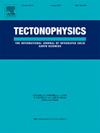侏罗纪至始新世萨卡里亚区东部的古地层运动
IF 2.7
3区 地球科学
Q2 GEOCHEMISTRY & GEOPHYSICS
引用次数: 0
摘要
研究区域涵盖图尔基耶北部萨卡里亚区东部南北走向的区域,北起黑海海岸线,南至凯尔基特盆地。本研究的目的是通过古地磁学研究侏罗纪-始新世时期萨卡里亚区东部的古地层运动。研究确定了从早侏罗世到中始新世时间跨度的各种火山和沉积单元(如森科伊、贝迪加、梅斯基特利、恰塔克、克孜勒卡亚和恰拉扬地层)。共选择了 98 个属于早/中侏罗世至始新世火山和沉积单元的地点进行古地磁岩芯样本采集。通过热法和交变磁场法对样本进行了退磁处理。获得了特征剩磁方向(ChRM)。还进行了等温剩磁(IRM)和高温电感(HTS)测量,以确定造成磁化的矿物。为了确定磁化是在岩石形成过程中获得的,还是随后的构造过程的结果,进行了砾岩和褶皱测试。结果表明,磁化是在褶皱之前获得的,即岩石具有原生磁化。还利用共生的正极性和反极性地点进行了极性测试。结果表明,侏罗纪早中期沉积岩和火山岩的平均磁化方向分别为 18.1°/55.2° (D/I)和 3.3°/51.5° (D/I),侏罗纪晚期/白垩纪早期沉积岩的平均磁化方向为 348.7°/46.7° (D/I)。在晚白垩世时期,沉积岩和火山岩的平均磁化方向分别为 8.0°/49.3° (D/I) 和 9.1°/47.0° (D/I)。在早/中始新世,沉积岩和火山岩的平均磁化方向分别为 348.6°/52.7° (D/I)和 5.9°/48.8° (D/I)。本研究对晚侏罗世/早白垩世沉积岩进行了 E/I 校正,并利用了从沉积岩中获得的古纬度数据。我们的古地磁结果表明,在早侏罗世-中始新世时期,东萨卡里亚区位于纬度跨度为 27.9° 至 35.7° 的区域。因此,在晚侏罗世和中始新世时期,萨卡里亚区东部构成了欧亚大陆南缘的一部分。本文章由计算机程序翻译,如有差异,请以英文原文为准。
Paleolatitudinal movements of the eastern Sakarya Zone from Jurassic to Eocene
The study area covers a region oriented north-south from the Black Sea coastline in the north to the Kelkit Basin in the south within the eastern Sakarya Zone in northern Türkiye. The objective of this study is to investigate the paleolatitudinal movements of the eastern Sakarya Zone during the Jurassic-Eocene time interval through paleomagnetism. Various volcanic and sedimentary units (e.g., the Şenköy, Berdiga, Mescitli, Çatak, Kızılkaya, and Çağlayan Formations) spanning the time interval from the Early Jurassic to Middle Eocene were identified. A total of 98 locations belonging to Early/Middle Jurassic to Eocene volcanic and sedimentary units were selected for paleomagnetic core sample collection. The samples were subjected to demagnetization through thermal and alternating field methods. Characteristic remanent magnetization directions (ChRM) were obtained. Isothermal remanent magnetization (IRM) and high temperature susceptibility (HTS) measurements were made to identify the minerals responsible for magnetization. To ascertain whether magnetization was acquired through rock formation or as a consequence of subsequent tectonic processes, conglomerate and fold tests were performed. The results showed that magnetization was acquired before folding, i.e., the rocks have primary magnetization. Polarity tests were also conducted using coeval normal and reverse polarity sites. The results indicate that the mean magnetization direction for the Early-Middle Jurassic is 18.1°/55.2° (D/I) and 3.3°/51.5° (D/I) for sedimentary and volcanic rocks, respectively, and 348.7°/46.7° (D/I) for Late Jurassic/Early Cretaceous sedimentary rocks. In the Late Cretaceous period, the mean magnetization direction is 8.0°/49.3° (D/I) and 9.1°/47.0° (D/I) for sedimentary and volcanic rocks, respectively. In the case of the Early/Middle Eocene, the mean magnetization direction is 348.6°/52.7° (D/I) and 5.9°/48.8° (D/I) for sedimentary and volcanic rocks, respectively. In this study, the E/I correction was applied to the Late Jurassic/Early Cretaceous sedimentary rocks, and paleolatitude data obtained from sedimentary rocks were also utilized. Our paleomagnetic results indicate that the eastern Sakarya Zone was situated at latitudes spanning from 27.9° to 35.7° during the Early Jurassic - Middle Eocene time interval. In consequence, the eastern Sakarya Zone constituted a portion of the southern margin of the Eurasian continent during the Late Jurassic and Middle Eocene periods.
求助全文
通过发布文献求助,成功后即可免费获取论文全文。
去求助
来源期刊

Tectonophysics
地学-地球化学与地球物理
CiteScore
4.90
自引率
6.90%
发文量
300
审稿时长
6 months
期刊介绍:
The prime focus of Tectonophysics will be high-impact original research and reviews in the fields of kinematics, structure, composition, and dynamics of the solid arth at all scales. Tectonophysics particularly encourages submission of papers based on the integration of a multitude of geophysical, geological, geochemical, geodynamic, and geotectonic methods
 求助内容:
求助内容: 应助结果提醒方式:
应助结果提醒方式:


